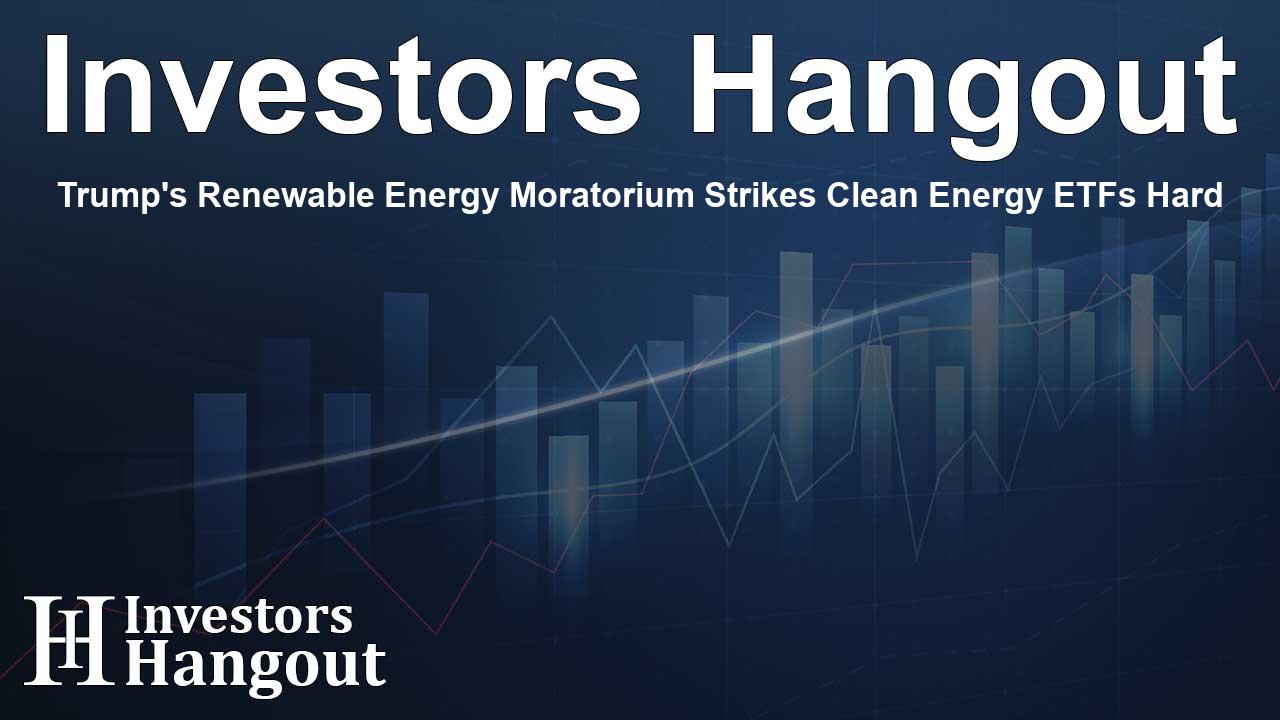Trump's Renewable Energy Moratorium Strikes Clean Energy ETFs Hard

Trump's Bold Stance Against Renewable Energy
President Donald Trump recently made headlines by announcing that his administration will cease approvals for new solar and wind power projects. This firm stance seems to deepen his already notable resistance toward renewable energy developments, stirring a wave of reactions across investment sectors.
Details of the Announcement
On social media, Trump voiced his discontent towards renewable energy initiatives, stating, “We will not approve wind or farmer destroying Solar.” His declaration is seen as a decisive move to reign in what he considers a misguided evolution in energy policy.
Market Reactions to the Policy Shift
As news of Trump's announcement spread, clean energy exchange-traded funds (ETFs) experienced declines. For example, the iShares Global Clean Energy ETF (ICLN) fell by 0.96% in after-hours trading to $14.25. Similarly, the First Trust NASDAQ Clean Edge Green Energy Index Fund (QCLN) saw a drop of 1.07%, ending the day at $36.67.
Impact on Various Clean Energy Funds
The Invesco WilderHill Clean Energy ETF (PBW) faced a 0.98% decrease, ending at $24.23, while the First Trust Global Wind Energy ETF (FAN) slipped by 0.26% to $18.86. These fluctuations highlight investor concerns regarding the future of renewable energy investments amid changing governmental policies.
Tax Incentives and Project Costs
Compounding the issue, Trump’s proposed One Big Beautiful Bill Act aims to terminate investment and production tax credits for wind and solar by 2027. This move, if enacted, could severely set back renewable energy growth in the country. Additionally, newly introduced tariffs on essential materials like steel and copper may escalate project costs, further complicating the landscape for developers.
Restrictions on Farmland Solar Installations
The U.S. Department of Agriculture has proclaimed the end of support for solar installations on farmland, adding another hurdle for renewable energy proponents who wish to expand their initiatives.
Supply-Demand Dynamics in Renewable Energy
Despite administrations taking a harder line against renewable projects, data from the Lawrence Berkeley National Laboratory indicates a different reality. The growing number of solar and battery storage projects suggests a persistent demand for new generation options. Notably, areas covered by PJM Interconnection have experienced electricity demand surges, particularly from data centers, leading to a 22% rise in capacity prices year-over-year as older coal plants retire.
Investor Concerns Deepen
The sudden policy changes have left many investors unsettled, particularly those with stakes in funds like ICLN, PBW, QCLN, and FAN. The uncertainty around governmental backing of renewable energies poses significant risks to existing investments and future growth in the sector.
Conclusion: Reflecting on the Future of Clean Energy
The recent developments reflect a pivotal moment for the renewable energy sector amidst Trump's shift in policy. Investors, industry participants, and advocates for clean energy must navigate this new landscape with caution as the implications of halted approvals and potential tax credit terminations unfold.
Frequently Asked Questions
What did Trump's announcement involve regarding renewable projects?
Trump announced a halt on approvals for new solar and wind power projects, pointing to a more aggressive energy policy.
How have clean energy ETFs been affected?
Following the announcement, ETFs like ICLN, PBW, QCLN, and FAN dropped significantly, reflecting investor concerns over future renewable energy policies.
What tax changes are proposed?
There are proposals to eliminate investment and production tax credits for renewable energy projects by 2027, which could impact sector growth.
Are there other restrictions being implemented?
The U.S. Department of Agriculture has ended support for solar projects on farmland, adding more challenges for renewable initiatives.
What does the market data indicate about demand for renewable energy?
Despite the negative policies, data shows rising project requests for solar and battery storage, indicating sustained interest and demand in renewable generation.
About The Author
Contact Kelly Martin privately here. Or send an email with ATTN: Kelly Martin as the subject to contact@investorshangout.com.
About Investors Hangout
Investors Hangout is a leading online stock forum for financial discussion and learning, offering a wide range of free tools and resources. It draws in traders of all levels, who exchange market knowledge, investigate trading tactics, and keep an eye on industry developments in real time. Featuring financial articles, stock message boards, quotes, charts, company profiles, and live news updates. Through cooperative learning and a wealth of informational resources, it helps users from novices creating their first portfolios to experts honing their techniques. Join Investors Hangout today: https://investorshangout.com/
The content of this article is based on factual, publicly available information and does not represent legal, financial, or investment advice. Investors Hangout does not offer financial advice, and the author is not a licensed financial advisor. Consult a qualified advisor before making any financial or investment decisions based on this article. This article should not be considered advice to purchase, sell, or hold any securities or other investments. If any of the material provided here is inaccurate, please contact us for corrections.
